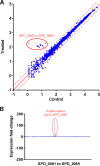A Quorum-Sensing System That Regulates Streptococcus pneumoniae Biofilm Formation and Surface Polysaccharide Production
- PMID: 28932816
- PMCID: PMC5597970
- DOI: 10.1128/mSphere.00324-17
A Quorum-Sensing System That Regulates Streptococcus pneumoniae Biofilm Formation and Surface Polysaccharide Production
Abstract
Despite vaccines, Streptococcus pneumoniae kills more than a million people yearly. Thus, understanding how pneumococci transition from commensals to pathogens is particularly relevant. Quorum sensing regulates collective behaviors and thus represents a potential driver of commensal-to-pathogen transitions. Rgg/small hydrophobic peptide (SHP) quorum-sensing systems are widespread in streptococci, yet they remain largely uncharacterized in S. pneumoniae. Using directional transcriptome sequencing, we show that the S. pneumoniae D39 Rgg0939/SHP system induces the transcription of a single gene cluster including shp and capsule gene homologs. Capsule size measurements determined by fluorescein isothiocyanate-dextran exclusion allowed assignment of the system to the regulation of surface polysaccharide expression. We found that the SHP pheromone induced exopolysaccharide expression in R36A, an unencapsulated derivative of D39. In the encapsulated parent strain, overexpression of the Rgg system resulted in a mutant with increased capsule size. In line with previous studies showing that capsule expression is inversely associated with biofilm formation, we found that biofilm formed on lung epithelial cells was decreased in the overexpression strain and increased in an rgg deletion mutant. Although no significant differences were observed between D39 and the rgg deletion mutant in a mouse model of lung infection, in competitive assays, overexpression reduced fitness. This is the first study to reveal a quorum-sensing system in streptococci that regulates exopolysaccharide synthesis from a site distinct from the original capsule locus. IMPORTANCE Quorum sensing regulates bacterial social behaviors by production, secretion, and sensing of pheromones. In this study, we characterized a new quorum-sensing system of the Rgg/SHP class in S. pneumoniae D39. The system was found to directly induce the expression of a single gene cluster comprising the gene for the SHP pheromone and genes with putative functions in capsule synthesis. Capsule size, as measured by dextran exclusion, was increased by SHP exposure in R36A, an unencapsulated derivative of D39. In the encapsulated parent strain, overexpression of the gene cluster increased capsule size, supporting the role of Rgg/SHP in the synthesis of surface polysaccharides. Further, we found that biofilm formation on epithelial cells was reduced by overexpression of the system and increased in a mutant with an rgg deletion. Placing surface polysaccharide expression under quorum-sensing regulation may enable S. pneumoniae to tune interactions with the host and other bacteria in accordance with environmental and cell density conditions.
Keywords: Streptococcus pneumoniae; biofilms; cell signaling; mutagenesis; natural transformation systems; polysaccharides; quorum sensing; rgg; shp; transcriptional regulation.
Figures









Similar articles
-
Identification of a Quorum Sensing System Regulating Capsule Polysaccharide Production and Biofilm Formation in Streptococcus zooepidemicus.Front Cell Infect Microbiol. 2019 Apr 18;9:121. doi: 10.3389/fcimb.2019.00121. eCollection 2019. Front Cell Infect Microbiol. 2019. PMID: 31058104 Free PMC article.
-
Characterization of a Signaling System in Streptococcus mitis That Mediates Interspecies Communication with Streptococcus pneumoniae.Appl Environ Microbiol. 2019 Jan 9;85(2):e02297-18. doi: 10.1128/AEM.02297-18. Print 2019 Jan 15. Appl Environ Microbiol. 2019. PMID: 30389765 Free PMC article.
-
Identification of Quorum-Sensing Inhibitors Disrupting Signaling between Rgg and Short Hydrophobic Peptides in Streptococci.mBio. 2015 May 12;6(3):e00393-15. doi: 10.1128/mBio.00393-15. mBio. 2015. PMID: 25968646 Free PMC article.
-
Quorum sensing in group A Streptococcus.Front Cell Infect Microbiol. 2014 Sep 12;4:127. doi: 10.3389/fcimb.2014.00127. eCollection 2014. Front Cell Infect Microbiol. 2014. PMID: 25309879 Free PMC article. Review.
-
Peptide pheromone signaling in Streptococcus and Enterococcus.FEMS Microbiol Rev. 2014 May;38(3):473-92. doi: 10.1111/1574-6976.12046. Epub 2013 Oct 31. FEMS Microbiol Rev. 2014. PMID: 24118108 Free PMC article. Review.
Cited by
-
Vitamin B3 Triggers Biosynthesis of Secondary Metabolite Dormancy Signals in Streptococcus suis.J Am Chem Soc. 2022 Aug 24;144(33):14997-15001. doi: 10.1021/jacs.2c05790. Epub 2022 Aug 15. J Am Chem Soc. 2022. PMID: 35969232 Free PMC article.
-
Host-Bacterial Interactions: Outcomes of Antimicrobial Peptide Applications.Membranes (Basel). 2022 Jul 19;12(7):715. doi: 10.3390/membranes12070715. Membranes (Basel). 2022. PMID: 35877918 Free PMC article. Review.
-
Peptide maturation molecules act as molecular gatekeepers to coordinate cell-cell communication in Streptococcus pneumoniae.Cell Rep. 2024 Jul 23;43(7):114432. doi: 10.1016/j.celrep.2024.114432. Epub 2024 Jul 3. Cell Rep. 2024. PMID: 38963762 Free PMC article.
-
The Rgg1518 transcriptional regulator is a necessary facet of sugar metabolism and virulence in Streptococcus pneumoniae.Mol Microbiol. 2021 Sep;116(3):996-1008. doi: 10.1111/mmi.14788. Epub 2021 Aug 10. Mol Microbiol. 2021. PMID: 34328238 Free PMC article.
-
Deletion of the Zinc Transporter Lipoprotein AdcAII Causes Hyperencapsulation of Streptococcus pneumoniae Associated with Distinct Alleles of the Type I Restriction-Modification System.mBio. 2020 Mar 31;11(2):e00445-20. doi: 10.1128/mBio.00445-20. mBio. 2020. PMID: 32234814 Free PMC article.
References
-
- O’Brien KL, Wolfson LJ, Watt JP, Henkle E, Deloria-Knoll M, McCall N, Lee E, Mulholland K, Levine OS, Cherian T, Hib and Pneumococcal Global Burden of Disease Study Team . 2009. Burden of disease caused by Streptococcus pneumoniae in children younger than 5 years: global estimates. Lancet 374:893–902. doi:10.1016/S0140-6736(09)61204-6. - DOI - PubMed
-
- Hamaluba M, Kandasamy R, Ndimah S, Morton R, Caccamo M, Robinson H, Kelly S, Field A, Norman L, Plested E, Thompson BA, Zafar A, Kerridge SA, Lazarus R, John T, Holmes J, Fenlon SN, Gould KA, Waight P, Hinds J, Crook D, Snape MD, Pollard AJ. 2015. A cross-sectional observational study of pneumococcal carriage in children, their parents, and older adults following the introduction of the 7-valent pneumococcal conjugate vaccine. Medicine 94:e335. doi:10.1097/MD.0000000000000335. - DOI - PMC - PubMed
-
- Le Polain de Waroux O, Flasche S, Prieto-Merino D, Edmunds WJ. 2014. Age-dependent prevalence of nasopharyngeal carriage of Streptococcus pneumoniae before conjugate vaccine introduction: a prediction model based on a meta-analysis. PLoS One 9:e86136. doi:10.1371/journal.pone.0086136. - DOI - PMC - PubMed
Grants and funding
LinkOut - more resources
Full Text Sources
Other Literature Sources
Molecular Biology Databases
